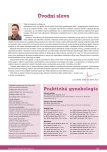-
Medical journals
- Career
Microbiological properties of endogenous vaginal flora strains in asymptomatic women of childbearing potential.
Authors: R. Krajčovičová 1; R. Hudeček 1; M. Chrápavá 2
Authors‘ workplace: Gynekologicko‑porodnická klinika LF MU a FN Brno 1; Valosun a. s., oddělení výzkumu a vývoje, Brno 2
Published in: Prakt Gyn 2009; 13(4): 192-201
Overview
Vaginal ecosystem is a complex system with intricate regulation that acts as a vaginal protection against exogenous infection. The complex nature of vaginal microenvironment and persisting therapeutic dilemmas incidental to treatment of women with chronic disturbance of vaginal ecosystem are the subject to research into vaginal flora aiming to compose a new therapeutic agent for restoration and stabilization of vaginal eumicrobia. During the experimental phase of the research, 35 samples – vaginal smears from asymptomatic women of childbearing potential – were examined. Bacterial strains were accurately identified and, following assessment of growth curves and vitality, ten bacterial strains were selected for further detailed examination of their specific characteristics. The research focused on testing of immunomodulatory activity (determination of fagocytary activity, fagocytosis index, lysozyme activity and peroxidase activity), bactericidal and candidacidal activity of the selected strains, ability to adhere to epithelial cells (lipophilicity testing), assessment of strain sensitivity to antibiotics (antibiogram) and determination of lactic acid and hydrogen peroxide production. Following detailed assessment, the following strains are considered to be ideal components of a probiotic preparation: 16A/ 1 Lactobacilus fermentatum (ideal immunostimulatory effects, high bactericidal and candidacidal activity), strain 17A Lactobacillus crispatus, 29B Lactobacillus acidophilus (stimulation of leukocyte fagocytary and leukocyte peroxidase activity) and strain 8A Lactobacillus gasseri (high antibacterial resistance). The effects of the optimal combination of endogenous vaginal flora probiotic strains in the treatment of vaginal infections and in restoring and stabilizing vaginal environment in the form of a new probiotic vaginal preparation will be tested in a subsequent clinical study.
Keywords:
vaginal ecosystem – endogenous vaginal flora – growth curve – lyophilization – bacterial strain vitality – immunomodulatory properties – hydrophobicity – bactericidal and candidacidal activity – antibiograms
Sources
1. Citterbart K et al. Gynekologie. Praha: Galén 2001 : 110 – 111.
2. Mašata J, Jedličková A et al. Infekce v gynekologii a porodnictví. Praha: Maxdorf 2004 : 23 – 33.
3. Cherpes TL, Hillier SL, Meyn LA et al. A Delicate Balance: Risk Factors for Acquisition of Bacterial Vaginosis Include Sexual Activity, Absence of Hydrogen Peroxide‑Producing Lactobacilli, Black Race, and Positive Herpes Simplex Virus Type 2 Serology. Sex Transm Dis 2008; 35(1): 78 – 83.
4. Calzolari E, Masciangelo R, Milite V et al. Bacterial vaginosis and contraceptive methods. Int J Gynecol Obstet 2000; 70 : 341 – 346.
5. Krajčovičová R, Hudeček R, Chrápavá M. Faktory ovlivňující vaginální eumikrobii. Prakt Gyn 2008; 12(4): 202 – 211.
6. Unzeitig V, Al Awad H. Nové možnosti stabilizace porušeného poševního prostředí. Prakt Gyn 2006; 10(5): 170 – 173.
7. Chrápavá M et al. Výkumní zpráva č.3 – Experimentální část projektu: průběh, popis, materiál, metodika, výsledky, Dotační program Impuls, č.: FI‑IM5/ 205, Ministerstvo průmyslu a obchodu, ČR.
Labels
Paediatric gynaecology Gynaecology and obstetrics Reproduction medicine
Article was published inPractical Gynecology

2009 Issue 4-
All articles in this issue
- Contrast enhanced ultrasound (CEUS) of impalpable breast lesions.
- Venous duct dopplerometry.
- Prognosis of women with breast cancer and sentinel lymph node micrometastases.
- Molecular- genetic analysis of tumor- suppressor genes PTEN and TP53 in a patient with endometrial carcinoma.
- Biological therapy – breast cancer.
- Traditional peruan medicine in the therapy of sterility.
- Rapid prenatal aneuploidy testing.
- Microbiological properties of endogenous vaginal flora strains in asymptomatic women of childbearing potential.
- Practical Gynecology
- Journal archive
- Current issue
- Online only
- About the journal
Most read in this issue- Venous duct dopplerometry.
- Prognosis of women with breast cancer and sentinel lymph node micrometastases.
- Contrast enhanced ultrasound (CEUS) of impalpable breast lesions.
- Microbiological properties of endogenous vaginal flora strains in asymptomatic women of childbearing potential.
Login#ADS_BOTTOM_SCRIPTS#Forgotten passwordEnter the email address that you registered with. We will send you instructions on how to set a new password.
- Career

